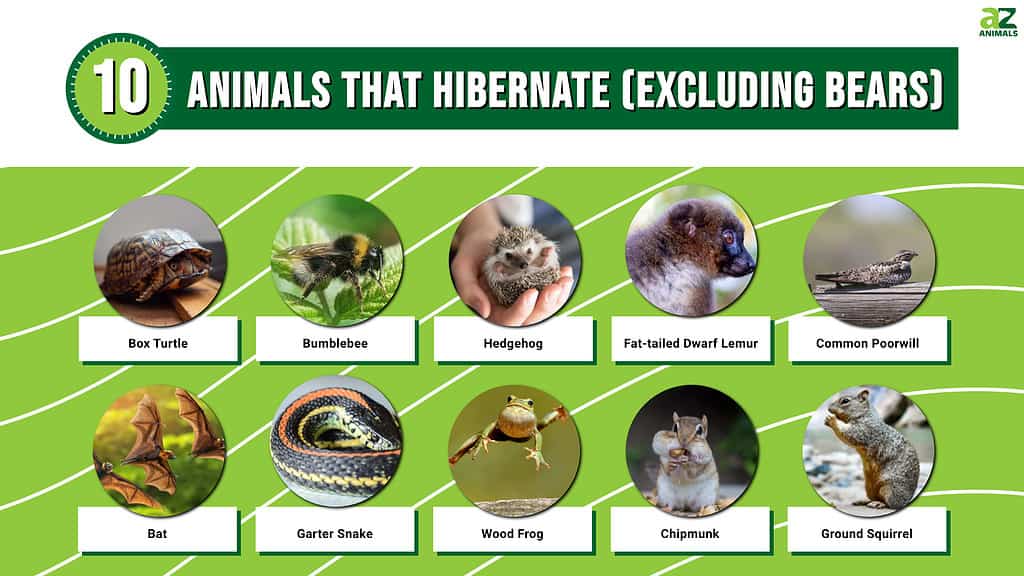
Bears sleep through winter, but are there other animals that hibernate? The answer is yes! Today, we’re looking at a variety of those that do.
But before we dive in, think about it. Why do certain animals hibernate?
One big reason revolves around conserving energy. Hibernating slows down an animal’s heart rate, metabolic system, breathing, and body temperature. In winter, food can be scarce, so this process allows them to survive with very little sustenance. Another reason, of course, is that hibernation helps them survive brutally cold winter temperatures.
Now let’s count down the top 10 hibernating animals other than bears. Ready? Let’s go!
#10 Hibernating Animal: Ground Squirrel
Unlike tree squirrels, many ground squirrels are all about burrowing.
With their brown fur and long claws, ground squirrels look near-identical to their arboreal-dwelling cousins. But instead of using their nails to climb, ground squirrels use them as shovels.
Dozens of ground squirrel species roam the earth — and not all hibernate. But sweetly, the ones that settle in for a long winter’s nap do so alongside friends and family. How cozy!
Ground Squirrel Fun Fact: Mama ground squirrels chew on shed snakeskin and then lick it onto their babies to obscure their natural scents — an effective safeguard against predation.
Click here to learn more about squirrels, which can find food a foot below snow.

Instead of using their nails to climb like tree squirrels, ground squirrels use them to burrow.
©Jan Stria/Shutterstock.com
#9 Hibernating Animal: Chipmunk
They love to eat nuts, frolic with friends, and a trio made it all the way to Hollywood! They’re chipmunks — and many hibernate for the winter.
During the fall, chipmunks pack their cheeks with acorns and stockpile food in burrows, which are usually about 3-feet underground. When subterranean, their temperatures plummet, and they sleep 23/7, occasionally waking to nosh on nuts. But once springtime sweeps in, chipmunks wake and immediately get to the business of play!
Chipmunk Fun Fact: Humans need about eight hours of sleep a day. Chipmunks need a whopping 15!
Click here to read more about Chipmunks, the world’s most adorable rodents.

During the fall, chipmunks pack their cheeks with acorns and stockpile food in burrows, which are usually about 3 feet underground.
©colacat/Shutterstock.com
#8 Hibernating Animal: Wood Frog
Wood frogs drift into natural cryogenic states every winter: their bodies freeze, yet they remain alive! When slumbering, wood frogs look dead, but don’t worry, they’re just sleeping — deeply!
Wood frogs don’t dig deep hibernation holes. Instead, they typically settle in just below ground. Often, piles of leaves or bark suit their needs. Once in place, they power down their respiratory and cardiovascular systems. That’s right: they’re hearts stop pumping! Then their body water turns to ice, and the hibernation shutdown is complete. When spring blooms, wood frogs thaw out and prepare for mating season.
Wood Frog Fun Fact: Wood frogs are the most northern dwelling amphibian in North America. Populations even exist in the Arctic Circle!
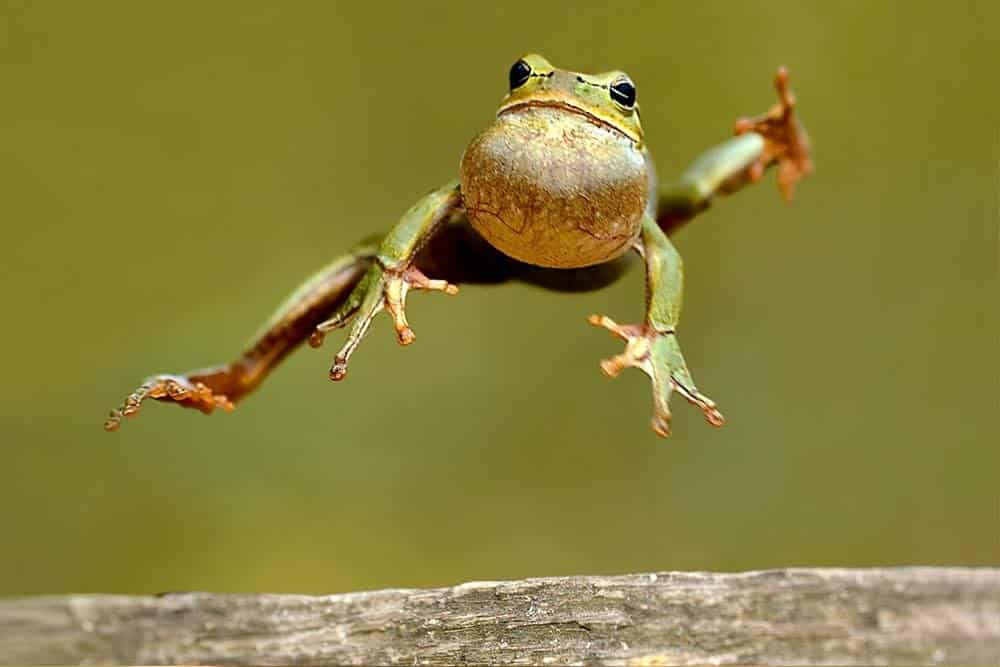
Wood frogs settle just below the ground surface to hibernate, and their bodies literally freeze until spring.
©kyslynskahal/Shutterstock.com
#7 Hibernating Animal: Garter Snake
Garter snakes in cold climates hibernate through the winter — and for garters, it’s a communal event. The reptiles slither long distances to find perfect hibernation huddles, and they pack into burrows like slapjacks — one on top of the other. Scientists once stumbled on a garter hibernation den with over 8,000 snakes!
Garter snakes carry trace amounts of venom that stun small animals, but it’s virtually harmless to humans, and many folks keep the reptiles as pets.
Garter Snake Fun Fake: Like nearly all snakes, garter snakes swallow their food whole.
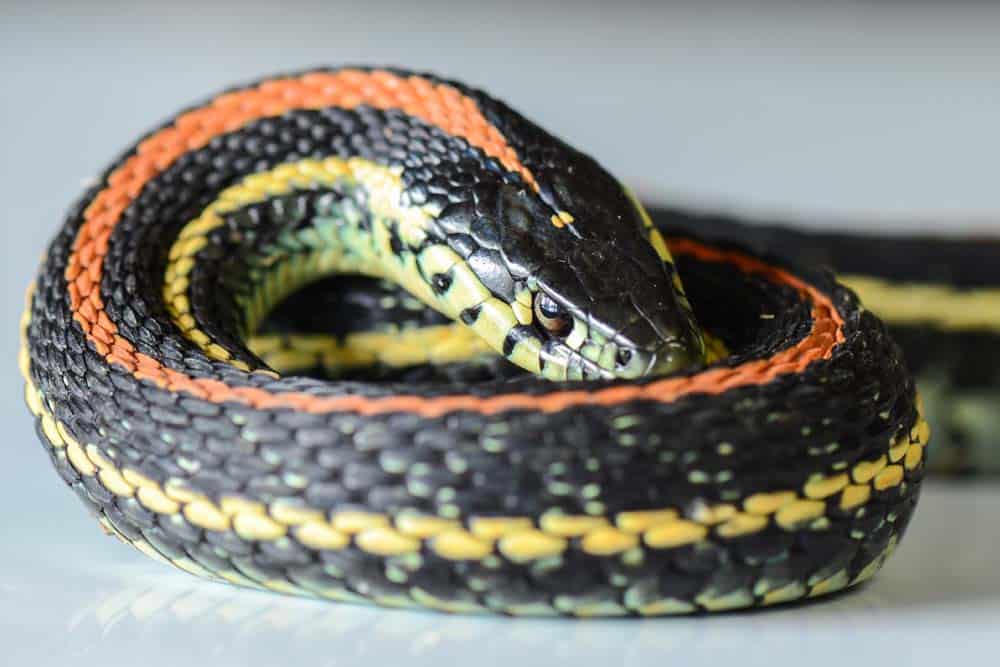
Garter snakes travel hibernate in groups and stack themselves into burrows on top of each other.
©Lost Mountain Studio/Shutterstock.com
#6 Hibernating Animal: Bat
Some species of bats, the Earth’s only flying mammals, hibernate. Ones that live in or migrate to warmer shores don’t, but those that make their homes in colder climates hunker down between late fall and mid-March.
Like most hibernating animals, bats’ temperatures nosedive for winter sleeps. But unlike some hibernators, bats don’t need to eat during their slumber. They simply shut down for six months and snooze 24/7.
If you have an attic, keep an eye out for hibernating bats. They have no problem flying in and setting up shop. As far as they’re concerned, su casa es their casa!
Bat Fun Fact: If bats disappeared, so would bananas, avocados, and mangoes.
Read more about bats, which use echolocation to get around.
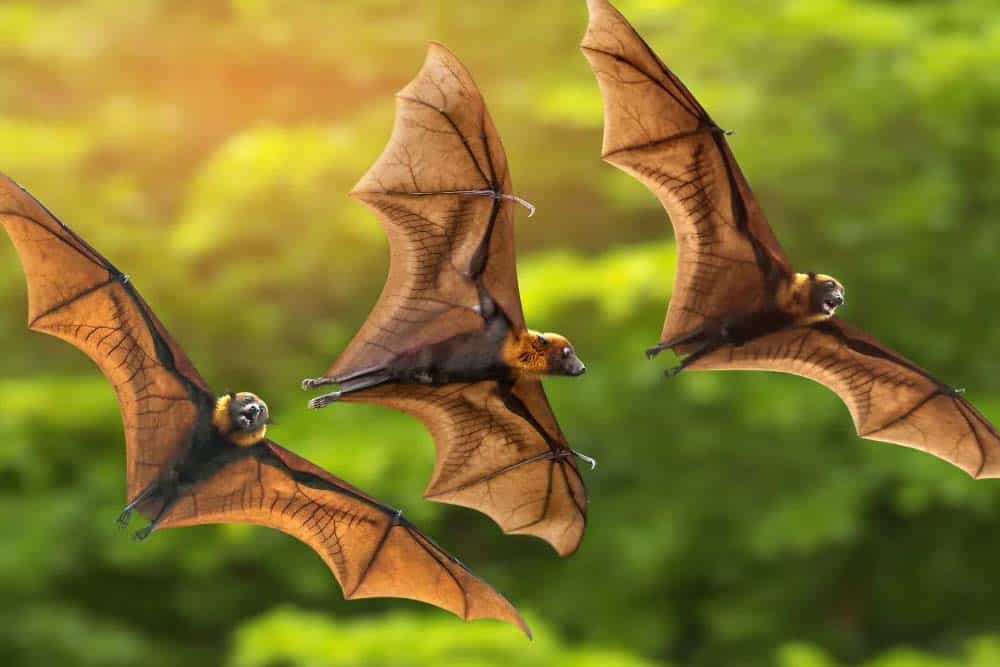
Bats that hibernate can go six months without eating.
©Independent birds/Shutterstock.com
#5 Hibernating Animal: Common Poorwill
Common poorwills are birds that are commonly found from British Columbia and South-Eastern Alberta, throughout the western United States to North of Mexico. They are nocturnal creatures and belong to the nighjar family. They prefer to live in dry open areas that have grass and shrubs and thrive in dry habitat, stony slopes and little green growth. During cold season many birds migrate to warmer areas, however, those who do not stay put and hunker down in piles or rock. They can lower their body temperature and enter a torpid state. Their heartbeat and breathing lowers down and they can stay that way for weeks at a time.
In the fall, poorwills feast on insects. During hibernation, their bodies extract nutrients from the digested and stored bug fat.
Common Poorwill Fun Fact: Common poorwills are the only known hibernating bird, and they look like mini owls.

Common poorwills are the only bird known to hibernate.
©vagabond54/Shutterstock.com
#4 Hibernating Animal: Fat-Tailed Dwarf Lemurs
You can find the adorable primates in Madagascar’s dry forests, but don’t search in the cold months — because fat-tailed dwarf lemurs hibernate. About five fat-tails will curl up together in a hollow tree to sleep the winter away. Their heart rate slows, as does their metabolism, and their bodies instinctively survive on fat storage.
Fat-Tailed Dwarf Lemur Fun Fact: Hibernating lemurs can slow their standard 800-beats-per-minute heart rate to just eight beats per minute!
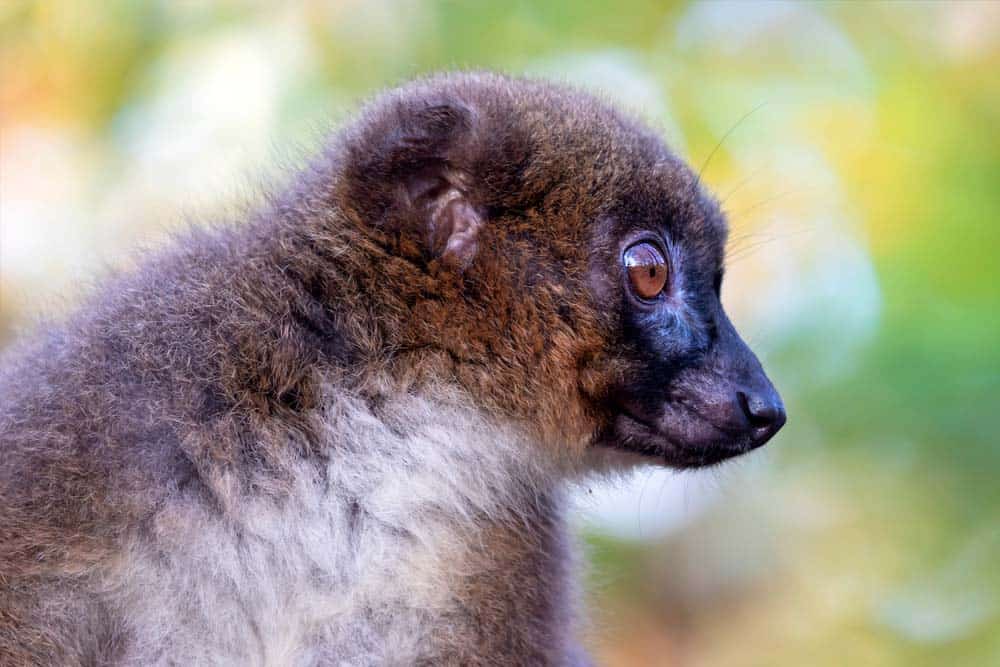
Fat tailed dwarf lemurs hibernate in groups.
©Edwin Butter/Shutterstock.com
#3 Hibernating Animal: Hedgehog
Some hedgehogs — porcupine lookalikes — hibernate in small, dry, protected areas far away from predators. You can usually find them sleeping in abandoned rabbit holes, under woodpiles, and even in compost heaps!
To survive hibernation, they need to weigh at least 600 grams. During the dormant period, their body temperatures lower to match their surroundings, their heart rates drop, and they’ll cease breathing for a while.Hedgehog Fun Fact: Hedgehogs are immune to snake venom. Yes, hedgehogs battle snakes — and often win!
Click to read more about hedgehogs, which are one of the oldest animals on Earth.
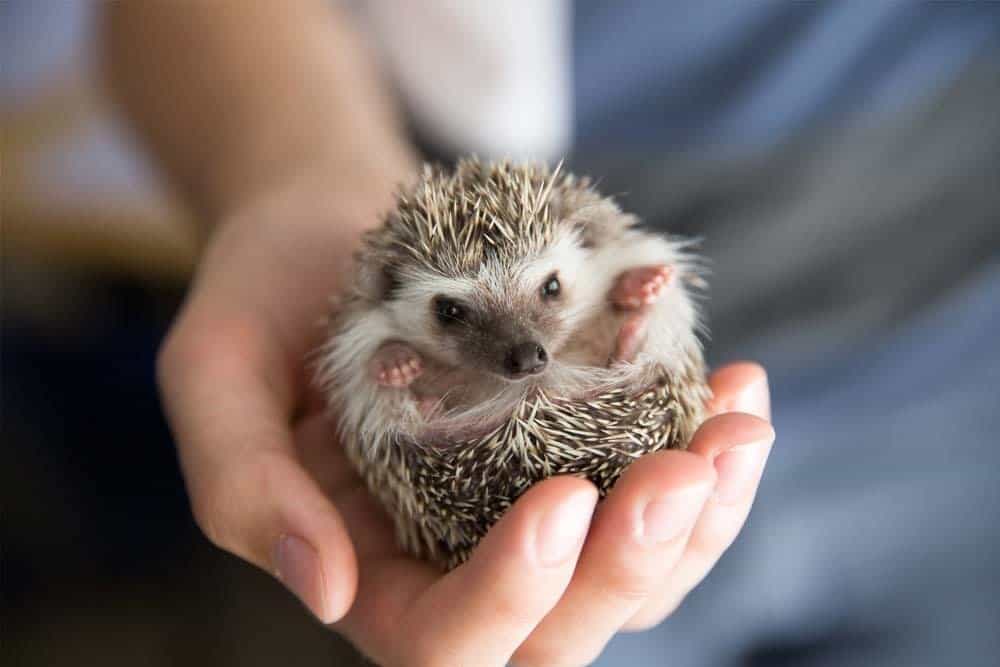
To survive hibernation, hedgehogs need to weigh at least 600 grams.
©Elijus3000/Shutterstock.com
#2 Hibernating Animal: Bumblebees
Where do bumblebees go during the winter? Sadly, most die in the fall, but queen bumblebees build hibernation hideouts for autumn and winter. In the spring, they start new colonies. Some buzzy ladies hibernate for up to nine months without eating anything!
Where do bumblebees hibernate? Mostly in strategically positioned dirt holes alee the winter sun.
Bumblebee Fun Fact: Bumblebees have smelly feet!
Learn more about bumblebees, which are the most common type of bee.
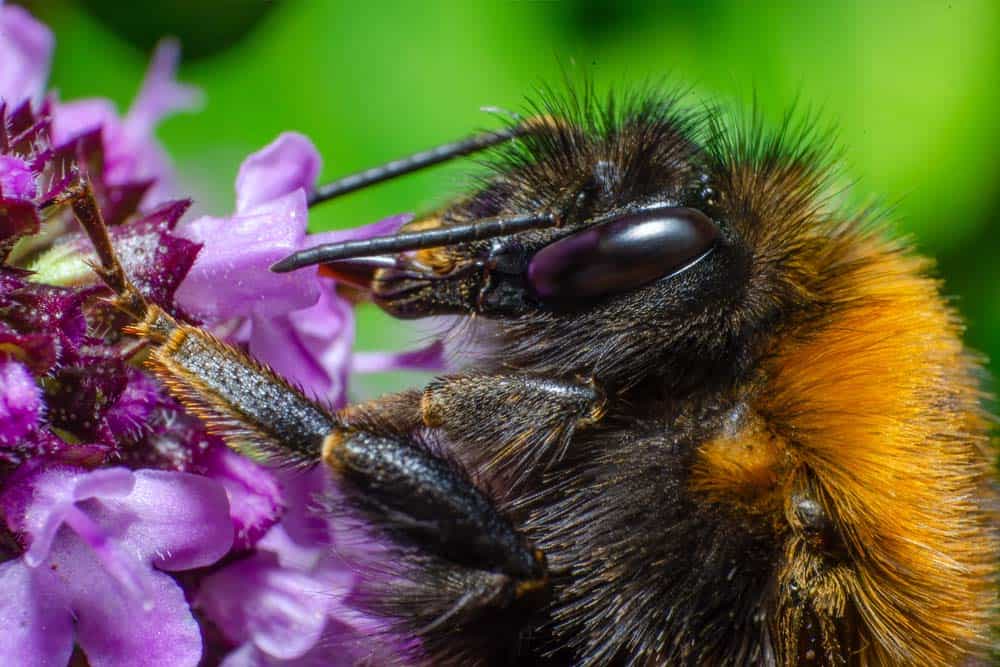
Most bumblebees die during the fall, but the queen hibernates and builds new colonies every spring.
©Edgar Rene Ruiz Lopez/Shutterstock.com
#1 Hibernating Animal: Box Turtles
Box turtles — the popular pet and wild animal — hibernate.
Unlike other animals that must make or find adequate hibernation accommodations, box turtles simply crawl inside their shells. They usually tuck in sometime between mid-September or early October and stay that way for three to four months.
Box Turtle Fun Fact: Box turtles have a soft shell until they’re seven years old.

To hibernate, box turtles simply crawl inside their shells for up to four months.
©Jessica Baldwin/Shutterstock.com
And there you have it, a list of animals that hibernate, which aren’t bears! Next up: The 10 Best Dogs for Apartment Living.
Summary of 10 Animals That Hibernate (Besides Bears):
| Animal | Hibernation Place |
|---|---|
| Box Turtle | Its shell. |
| Bumblebee | The queen builds a place for herself in a strategically positioned dirt hole. |
| Hedgehog | Small, dry, protected areas such as rabbit holes or under woodpiles or compost heaps. |
| Fat-Tailed Dwarf Lemur | About five will huddle together in a hollow tree. |
| Common Poorwill | In piles of grass or rocks. |
| Bat | In caves, mines, rock crevices, attics, and other structures with ideal temperature and humidity. |
| Garter Snake | Many will pile up together in burrows. |
| Wood Frog | In a shallow hole or a pile of leaves or bark. |
| Chipmunk | In burrows about 3 feet underground. |
| Ground Squirrel | In a group in a burrow. |
The photo featured at the top of this post is © Elijus3000/Shutterstock.com
Thank you for reading! Have some feedback for us? Contact the AZ Animals editorial team.






